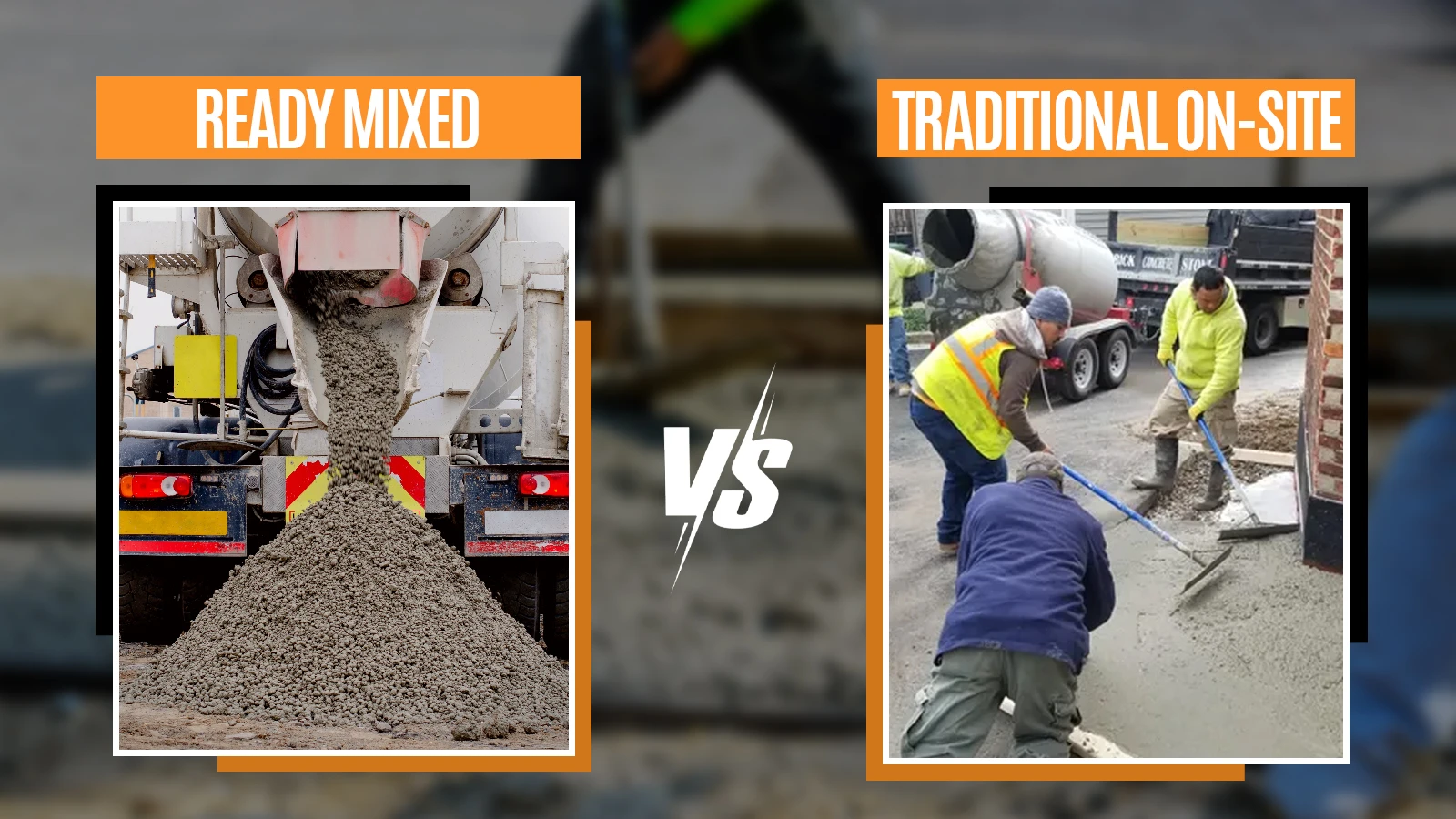[TL;DR]
Choosing between Ready Mixed and Traditional Mixing affects your project’s time, cost, and workflow. Ready mix offers speed and consistency, perfect for larger jobs. Traditional mixing gives more control and flexibility, especially for smaller or changing projects. The right choice helps avoid delays, reduce waste, and keep everything running smoothly.
Construction projects face constant pressure to reduce costs and meet tight deadlines. The choice between ready mix concrete vs normal concrete directly impacts both your budget and timeline. Professional concrete suppliers understand these pressures and offer solutions that maximise efficiency. The concrete mixing method you select affects labour costs, equipment expenses, and project duration. Understanding these differences helps construction managers make informed decisions that save both time and money.
42.6% of construction projects face time delays. Material delivery issues account for 40% of these delays. Choosing the right concrete mixing method can prevent costly project overruns.
Pro-Mix Concrete delivers both ready mixed and Traditional on-site mixing solutions across London and the UK. Our 20+ years of experience show how the right choice can reduce project costs by up to 30% while improving timeline performance.
Contact Pro-Mix Concrete: 020 7458 4747
What Is Ready-Mixed Concrete?
Ready-mixed concrete is pre-mixed concrete produced at specialised batching plants and delivered fresh to construction sites. This method ensures consistent quality through automated processes and professional quality control.
Key Features: Consistency, Quality Control, and Automation
Computer-controlled batching delivers consistent concrete properties. Professional quality assurance teams monitor every production stage. Automated systems reduce variability between batches.
Key consistency features include:
- Precise material proportioning
- Standardised mixing procedures
- Professional quality testing
- Certified mix designs
What Is Traditional On-Site Mixing?
Traditional on site concrete mixing involves combining concrete ingredients directly at the construction site using portable equipment. This method provides maximum flexibility for mix adjustments and timing control. Traditional concrete mixing offers unmatched flexibility for concrete modifications. Operators can adjust water content, add admixtures, or modify consistency during mixing. This adaptability suits projects with changing requirements.
At Pro-Mix Concrete, we provide both ready-mixed concrete delivery and specialised on-site mixing equipment with trained operators. Our flexible service options adapt to your project’s specific timeline and budget requirements, ensuring optimal cost efficiency for any construction scenario.
Call Us Now: 020 7458 4747
Time Savings: Ready Mixed vs. On-Site Mixing
Ready mix concrete vs normal concrete time efficiency depends on project scale and logistics. Ready-mixed concrete generally saves time on larger projects, while on-site mixing offers timing flexibility for smaller jobs.
Ready Mixed: Faster Deployment and Reduced On-Site Labour
Ready-mixed concrete delivers immediate placement capability. Trucks arrive ready to pour, eliminating mixing time and reducing on-site labour requirements. Large volumes can be placed quickly with minimal crew sizes.
Time-saving benefits include:
- No mixing delays
- Reduced labour crews
- Faster placement rates
- Immediate availability
On-Site Mixing: Longer Preparation Time and Potential Delays
Traditional mixing requires setup time for equipment and materials. Mixing each batch takes additional time compared to ready-delivery concrete. Weather and equipment issues can cause delays. However, Traditional mixing eliminates delivery scheduling constraints and transportation delays.
Impact of Project Size and Complexity on Time Efficiency
Large projects benefit more from ready-mixed concrete’s rapid deployment. Small projects may find traditional concrete mixing more time-efficient due to reduced coordination requirements. Complex projects with multiple concrete grades may favour traditional concrete mixing for its adaptability.
Cost Considerations: Which Method Saves Money?
Cost analysis must consider upfront expenses, labour efficiency, and long-term performance. Ready mix concrete vs normal concrete costs vary significantly based on project parameters and local market conditions.
Upfront Costs: Material, Equipment, and Transportation
Ready mixed concrete includes material, mixing, and delivery costs in one price. Transportation adds distance-based charges but eliminates equipment rental expenses. On-site mixing separates material costs from equipment and labour expenses. Equipment rental, fuel, and operator wages create additional cost categories.
Labour Costs and Efficiency Differences
Ready mixed concrete reduces on-site labour requirements by 40-60%. Smaller crews can handle larger concrete volumes, reducing hourly labour expenses. On-site mixing requires operators, material handlers, and quality control staff. These additional personnel increase project labour costs.
Potential Waste and Rework Expenses
Ready-mix concrete minimises waste through precise ordering and professional quality control. Unused concrete represents a direct cost loss. On-site mixing allows exact quantity production but increases rework risks from quality variations. Poor mixing can require costly repairs or replacement.
Long-Term Costs: Durability, Maintenance, and Repairs
Consistent, ready-mix concrete quality reduces long-term maintenance costs. Professional production minimises strength variations and durability issues. Variable on-site mixing quality can increase future repair and maintenance expenses.
Quality and Consistency Impact on Cost and Time
Quality variations directly affect project costs and timelines. Consistent concrete reduces inspection time, rework expenses, and long-term maintenance costs.
Quality Assurance in Ready Mixed Concrete
Central plants maintain strict quality control through automated batching and professional testing. Every batch meets specification requirements before delivery.
Quality control measures include:
- Laboratory testing protocols
- Certified mix designs
- Computer-controlled batching
- Professional oversight
Variability Risks and Quality Control in On-Site Mixes
On-site mixing faces higher quality variation risks. Human error in proportioning, inadequate mixing time, and environmental factors can affect concrete properties. Proper training and procedures minimise these risks but cannot eliminate them entirely.
Logistical and Environmental Factors
Logistics and environmental considerations influence both cost and time efficiency. Site constraints, delivery scheduling, and waste management affect overall project economics.
Delivery and Scheduling Challenges for Ready Mix
Ready-mix concrete requires advanced scheduling and site access for delivery trucks. Traffic conditions and site constraints can affect delivery timing. Coordination with placement crews ensures concrete arrives when needed without delays.
Material Storage and Handling for On-Site Mixing
On-site mixing requires substantial material storage areas and handling equipment. Weather protection for cement and proper aggregate storage add logistical complexity. Storage costs and space requirements increase project overhead expenses.
Waste Management and Environmental Sustainability
Ready-mix concrete producers optimize material usage and recycle wash water. Centralised production achieves better environmental efficiency than individual project sites. On-site mixing generates packaging waste and requires proper disposal procedures.
Pro-Mix Concrete’s network of local suppliers and concrete pump hire services provides the logistical flexibility you need while maintaining cost efficiency. Our same-day and next-day delivery options, combined with our professional pump operators, ensure your project stays on schedule and within budget regardless of site constraints.
Schedule Efficient Concrete Delivery: 020 7458 4747
Choosing the Best Option Based on Project Needs
Project characteristics determine which mixing method provides superior time and cost savings. Size, location, and complexity influence the optimal choice for your specific situation.
Large-Scale vs. Small or Remote Projects
Large-scale projects benefit from ready-mixed concrete’s efficiency and consistency. Small projects may find on-site mixing more cost-effective due to minimum order requirements. Remote locations favour on-site mixing when transportation costs become prohibitive.
Accessibility, Equipment Availability, and Site Constraints
Site access limitations may prevent ready-mix concrete delivery. Restricted spaces favour smaller on-site mixing equipment. Equipment availability and local market conditions influence method selection and costs.
Customisation Requirements and Flexibility Needs
Projects requiring frequent mix modifications benefit from on-site mixing flexibility. Standard specifications favour ready-mix concrete’s consistency and efficiency.
Takeaway
Ready-mix concrete and normal concrete selection significantly impact project time and cost efficiency. Ready-mixed concrete delivers superior time savings and cost efficiency for medium to large projects through reduced labour requirements, faster placement, and consistent quality. Traditional concrete mixing provides flexibility advantages for small projects, remote locations, and applications requiring frequent adjustments.
Want to optimise your concrete costs and project timeline?
Pro-Mix Concrete brings 20+ years of expertise in both ready mixed and on-site concrete solutions across London and the UK. Our professional team understands that every project has unique time and budget constraints.
Drop Us A Line: 020 7458 4747
Frequently Asked Questions
Does ready-mixed concrete always save time compared to on-site mixing?
Ready mix concrete saves time on projects over 30 cubic meters through faster deployment and reduced labour. Smaller projects may show minimal time differences between methods.
Is on-site mixing cheaper than ready-mix concrete for all projects?
On-site mixing costs less for projects under 20 cubic meters due to minimum order requirements. Larger projects benefit from ready-mixed concrete’s labour efficiency.
How does concrete quality affect project cost and duration?
Quality variations cause rework that adds 15-20% to project costs and delays completion. Consistent concrete quality maintains schedules and prevents expensive repairs.
What are the environmental impacts of each mixing method?
Ready-mix concrete achieves better environmental efficiency through centralised production and waste recycling. On-site mixing generates more packaging waste per cubic meter.
Can site conditions limit the use of ready-mix concrete?
Limited site access can prevent ready-mix concrete delivery trucks from reaching placement areas. Narrow spaces favour smaller on-site mixing equipment.
How do transportation and storage influence overall costs?
Transportation costs increase with distance for ready mixed concrete, while storage costs affect on-site mixing. Local market conditions determine which factor dominates total costs.
- Dennis Broderick
- Dennis Broderick is the founder and owner of Pro-Mix Concrete Company, a trusted name in ready-mix concrete solutions across the UK. With over 20 years of hands-on experience in the construction and concrete industry, Dennis brings unmatched expertise, practical insights, and a commitment to quality on every project - from residential driveways to large-scale commercial developments.
BlogNovember 26, 2025Ready Mix Concrete Costs UK: 7 Key Factors That Affect Your Price Per m³
BlogNovember 26, 2025How Long Does Concrete Take To Cure?
BlogNovember 20, 2025How To Measure Concrete With A Concrete Calculator?
BlogNovember 15, 2025What is the Mix Proportion of Concrete?









